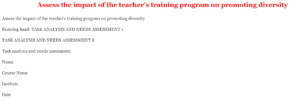Assess the impact of the teacher’s training program on promoting diversity
Assess the impact of the teacher’s training program on promoting diversity
Assess the impact of the teacher’s training program on promoting diversity
Running head: TASK ANALYSIS AND NEEDS ASSESSMENT 1
TASK ANALYSIS AND NEEDS ASSESSMENT 8
Task analysis and needs assessment
Name
Course Name
Institute
Date
Introduction
Assess the impact of the teacher’s training program on promoting diversity
In the present day, diversity and its accompanying element of inclusion such as unconscious bias based on racial and religious differences as well as disabilities have become an unavoidable and crucially important characteristic in the training of the members of different organizations in order to make them successful. Without the aspect of rivalry for the greatest abilities in the marketplace as well as the training of the individuals without any differences and bias, the institutions would become unmanageable. This effectively established the foundation for employment opportunities and the treatment of people belonging to different backgrounds (Whitford & Emerson,, 2019). Inclusion of diversity and unconscious bias continues to play an important role within different organizations particularly educational institutes from the last few centuries. The diversity in the training of the teachers encompasses not just variances among employees, but also the understanding and comprehension of such disparities in the pursuit of a common purpose. In public as well as private educational institutions, it is commonly seen that the teachers bias the students on the basis of their disabilities, gender differences, and racial and religious appearances. As a result of such bias, the teachers are unable to give proper and equal knowledge and learning to the students, which ultimately leads to influence their academic performance (Bruneau et al., 2020). Therefore, there is a strong need for the Unconscious bias, diversity, and inclusion training for teachers in the public school system. This paper would reflect on the task analysis theories and assessment of needs that are required for improving the concern of unconscious bias of the teachers towards their students.
Task analysis theory
Task analysis is considered to be an important aspect in determining the progress of the organization. This theory determines the performance of the teachers in their tasks and responsibilities and the first thing that is needed for determining the role of teachers is to collect data. Once the data is collected, it can be determined in which areas the teachers need improvement. For instance, if it is determined from the collected data that the teachers are unconsciously discriminating against the students, as a result of which, it would be easy to implement the strategies and take the measures that lead to decreasing the bias and discrimination by giving proper training to the teachers on the aspect of LGBTQ, racial and religious differences (Francis et al., 2019). Furthermore, the task analysis theory assists in comprehending in what ways, the training programs of teachers can be implemented in which they prove to be efficient and productive.
In different researches, it is reported that after the completion of task analysis, the teachers can be trained in an efficient manner without facing any difficulty. It is a fact that a skill cannot be inculcated in all the teaching staff at once, therefore, task analysis would help in solving this issue (Carter et al., 2020). Moreover, the task analysis of training the teachers comprise different steps such as identification of the target capabilities of teacher, their tasks and responsibilities within the school, limitations of teachers that require their training, aspects in which training can lead to positive impacts, and implementing the appropriate measures and approaches.
For this essay, the aspect of the training of teachers has been selected as it is observed that teachers are the ones who are responsible for giving knowledge to their students and if the teachers bias or discriminate against them intentionally or unintentionally, then it would lead to affecting the self-esteem and personality of the students. Furthermore, such students are unable to properly show their talents and capabilities in front of the teachers because they assume that they will always are degraded for their performance (Quinn, 2020). This shows that the teachers need training in which they are informed about the factors that affect their ways of educating the children. For example, if the teacher encounters a physically disabled student in class, then he unintentionally discriminates against him because of his appearance. Similarly, the teacher would discriminate against such students who wear Hijab and believe in a different religion from her. As a result of such religious differences, the teachers cannot educate her like the way she teaches other students as she believes that such students would have different beliefs. Such discrimination and biases toward her would automatically lead to influence her academic status (Starck et al., 2020). Therefore, to resolve this unintentional bias and promote diversity within the educational institutes, the teachers need a training program for which task analysis is considered to be one of the effective strategies. In the case of training teachers, the first step in the task analysis method includes determining the tasks of teachers. Once their tasks and responsibilities are determined, the most effective method i.e., the feedback method will be used to determine how the teachers are being trained and in what aspects they need training. In the next step, the aspects will be shortlisted for which the training program needs to be developed. In the last step, the success of the desired tasks will be determined that whether we are able to accomplish the task and what challenges have been encountered during the execution of tasks.
Need Assessment: Task Analysis
Responsibilities and Tasks of Teachers
In order to implement the task analysis methods, the first and foremost method is to demonstrate the responsibilities and tasks of teachers. Teachers play an important role in communicating and passing on their knowledge to the students, who are considered to be the intellectuals and scientists of the upcoming future. Their key tasks and responsibilities include assuring that every student is acquiring quality and standard education, increasing the level of self-esteem in students by giving them knowledge, as well as preparing curriculum and learning plans for the students (Robinson et al., 2020). Also, teachers have a significant role in the administrative part.
Feedback Method
The second step in the task analysis method is gaining feedback from the students. A particular individual would be selected for this purpose who will take feedback from the students that how their teachers educate them, their time of teaching, and their behavior in class with all the students. By collecting feedback from different students, it can be determined whether the teachers bias the students particularly if the student appears religiously different and have some kind of disability.
Aspects requiring training
Once the feedback method is completed, all the areas and aspects of teachers which require training are shortlisted. For instance, in the case of teachers, we have determined that different factors such as stereotype threat, psychological thinking, and negative beliefs towards the people of other religions and backgrounds are considered to be the underlying reasons for the unconscious bias of teachers toward their students. Furthermore, after analyzing the feedback collected from students, it is determined that the students feel discouraged and are failed to give good grades due to such discrimination. Thus, such analysis depicts that teachers need training on diversity and unconscious bias so that they can fulfill their responsibility of providing quality education to every single student within the school.
Execution of training program
After determining the areas which need to be reformed, the training program is executed in which every teacher is informed about the fact that every individual has their own beliefs and faith. Additionally, disability is not in the hands of the individual; therefore, students must not be discriminated against or biased by these factors. Also, they are trained that they should promote diversity within the educational institutes, which helps the students as well as teachers in comprehending the cultures, religions, and traditions of one another. As a result of such diversity, a peaceful and productive environment will be created in schools, which motivate the students in acquiring knowledge without feeling low and inferior. The training program will be conducted in a way that every week, the teachers learn new aspects during their training session that how they can overcome their stereotypic thoughts and focus on providing equal education to every student. The last step includes the analysis that whether the implemented tasks are being accomplished or not. For this purpose, the duration in which the task has been completed is determined and also assesses the impact of the teacher’s training program on promoting diversity and decreasing unconscious bias.
Conclusion
Thus, it is concluded that task analysis plays a vital role in unconscious bias, diversity, and inclusion training for teachers in the public school system. As teacher’s unintentional bias toward students is one of the rising concerns and leading factors for the reduced academic performance of the students. Therefore, the task analysis method is executed in order to determine the difference that it made in improving the behavior of the teachers towards their students and improving their confidence and academic knowledge. For completing the tasks analysis method effectively, the responsibilities of teachers are determined, after which feedback is collected from the students which reveals that most teachers discriminate against students due to their stereotyping thinking. From these results, a suitable training program is designed for the teachers after which the success of every single task is determined. Also, the comparison is made before and after training.
References
Bruneau, E., Szekeres, H., Kteily, N., Tropp, L. R., & Kende, A. (2020). Beyond dislike: Blatant dehumanization predicts teacher discrimination. Group Processes & Intergroup Relations, 23(4), 560-577.
Carter, E. R., Onyeador, I. N., & Lewis Jr, N. A. (2020). Developing & delivering effective anti-bias training: Challenges & recommendations. Behavioral Science & Policy, 6(1), 57-70.
Francis, D. V., de Oliveira, A. C., & Dimmitt, C. (2019). Do school counselors exhibit bias in recommending students for advanced coursework?. The BE Journal of Economic Analysis & Policy, 19(4).
Quinn, D. M. (2020). Experimental evidence on teachers’ racial bias in student evaluation: The role of grading scales. Educational Evaluation and Policy Analysis, 42(3), 375-392.
Robinson, C., Phillips, L., & Quennerstedt, A. (2020). Human rights education: developing a theoretical understanding of teachers’ responsibilities. Educational Review, 72(2), 220-241.
Starck, J. G., Riddle, T., Sinclair, S., & Warikoo, N. (2020). Teachers are people too: Examining the racial bias of teachers compared to other American adults. Educational Researcher, 49(4), 273-284.
Whitford, D. K., & Emerson, A. M. (2019). Empathy intervention to reduce implicit bias in pre-service teachers. Psychological reports, 122(2), 670-688.
Use the following coupon code :
premiernursingpapers


